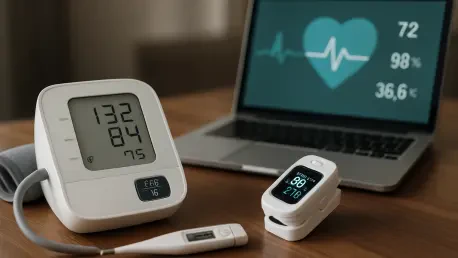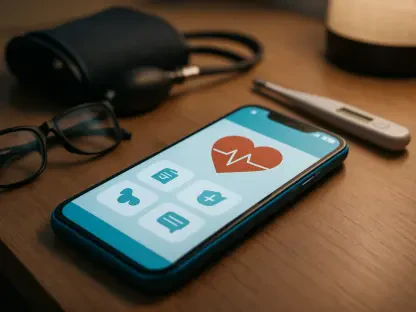Imagine a scenario where a patient struggling with anxiety or depression no longer has to wait for a scheduled appointment to get help, and subtle changes in their mental state are detected and addressed before they escalate into a full-blown crisis. Remote Patient Monitoring (RPM) is turning this vision into reality within behavioral health care. Leveraging digital tools such as smartphones, wearable devices, and specialized apps, RPM enables continuous tracking of symptoms and behaviors, creating a vital connection between patients and clinicians outside traditional settings. This technological shift is redefining support for individuals with mental health conditions or substance use disorders, ensuring that care extends far beyond the walls of a doctor’s office. The promise of early intervention and personalized treatment is becoming tangible, offering hope to millions who face daily challenges with their mental well-being. As this innovation gains traction, it’s clear that RPM is not just a trend but a fundamental change in how behavioral health services are delivered.
The impact of RPM goes beyond mere convenience, striking at the heart of some of the most pressing issues in mental health care. By providing real-time data, it empowers clinicians to tailor interventions to individual needs, potentially preventing relapses or emergencies. For patients, the ability to actively participate in their care through self-monitoring tools fosters a sense of control and engagement. Yet, the road to widespread adoption is not without obstacles, as barriers like data management, privacy concerns, and unequal access to technology persist. Despite these challenges, the transformative potential of RPM is evident in groundbreaking practices that are already reshaping the field. From wearable devices to location-based alerts, these tools are proving their worth in enhancing outcomes and reducing strain on healthcare systems. The question remains: how are these innovations being applied, and what does their future hold for behavioral health?
The Rise of RPM in Behavioral Health
Why RPM Matters for Mental Health
Remote Patient Monitoring has emerged as a pivotal tool in behavioral health, addressing the critical need for ongoing oversight in a field where symptoms can change rapidly and often unpredictably. Unlike physical health conditions with more visible indicators, mental health challenges like depression or bipolar disorder may manifest subtly, making early detection difficult without constant observation. RPM fills this gap by utilizing digital platforms to track mood, behavior, and physiological signals in real time. This capability allows clinicians to identify warning signs—such as increased anxiety or disrupted sleep patterns—before they spiral into crises. The significance of this technology lies in its ability to create a safety net, ensuring that patients receive timely support even when they’re not in a clinical setting. As mental health needs continue to rise globally, RPM offers a scalable solution to monitor and manage conditions more effectively, reducing the burden on overtaxed healthcare systems.
Moreover, the value of RPM extends to fostering a proactive rather than reactive approach to mental health care. Traditional models often rely on episodic visits, where patients might downplay or overlook symptoms until they become severe. With RPM, continuous data collection provides a clearer, more comprehensive picture of a patient’s well-being over time. For instance, a sudden drop in activity levels captured by a wearable device could prompt a clinician to check in, potentially averting a depressive episode. This shift toward prevention is particularly crucial in behavioral health, where delays in intervention can lead to hospitalization or worse. By enabling earlier responses, RPM not only improves patient outcomes but also helps to destigmatize seeking help by normalizing regular monitoring as part of everyday life. The focus on prevention over crisis management marks a significant evolution in how mental health support is conceptualized and delivered.
Bridging Gaps in Care
Access to behavioral health services remains a persistent challenge, especially for individuals in rural or underserved communities where specialized care is often scarce. RPM serves as a vital bridge, extending the reach of clinicians through digital means and ensuring that distance or resource limitations do not equate to neglect. Telehealth platforms and monitoring tools allow patients to connect with providers regardless of location, receiving guidance or adjustments to treatment plans without the need for travel. This is particularly impactful for those with mobility issues or severe anxiety that makes in-person visits daunting. However, while RPM offers a lifeline, disparities in digital access—such as lack of reliable internet or devices—can exclude the very populations who need it most. Addressing these inequities is essential to ensure that the benefits of remote care are distributed fairly across all demographics.
In addition to geographic barriers, RPM helps overcome temporal gaps in care by maintaining continuity between appointments. Behavioral health conditions often fluctuate outside of scheduled check-ins, leaving patients vulnerable during these intervals. Digital tools provide a constant line of communication, enabling alerts for concerning trends or immediate feedback on self-reported data. This ongoing connection can be a game-changer for managing chronic conditions like substance use disorders, where a single lapse can undo months of progress. Yet, the effectiveness of RPM in bridging these gaps depends on robust infrastructure and support systems to ensure patients can engage with the technology. Without targeted efforts to improve digital literacy and provide affordable access, the risk remains that RPM could inadvertently widen existing disparities rather than close them. Balancing innovation with inclusivity is key to realizing its full potential.
Innovative Practices Driving Change
Wearables and Physiological Tracking
Among the most promising developments in RPM for behavioral health is the use of wearable devices to monitor physiological markers that reflect mental states. These tools, such as smartwatches or fitness trackers, capture data on sleep patterns, heart rate variability, and physical activity levels, which can serve as indirect indicators of emotional well-being. For example, a noticeable reduction in sleep duration might signal the onset of a manic episode in a patient with bipolar disorder, prompting timely intervention. This approach provides clinicians with objective insights that complement subjective reports, creating a more holistic view of a patient’s condition. The non-invasive nature of wearables also makes them user-friendly, encouraging consistent use among patients who might otherwise resist more intrusive monitoring methods. As these devices become more sophisticated, their role in detecting subtle shifts in mental health status continues to grow.
Furthermore, the integration of wearable data into treatment plans represents a shift toward evidence-based personalization in behavioral health care. Clinicians can analyze trends over time to identify patterns unique to each patient, adjusting therapies or medications based on real-world evidence rather than solely on periodic assessments. This data-driven approach enhances precision, potentially reducing trial-and-error in finding effective interventions. However, the challenge lies in managing the sheer volume of information these devices generate, ensuring that it translates into actionable insights rather than overwhelming providers. Educating both clinicians and patients on interpreting this data is crucial to maximizing its benefits. By turning raw numbers into meaningful health strategies, wearables are carving out a significant space in the future of mental health monitoring, offering a glimpse into conditions that were once invisible outside clinical walls.
Mobile Apps and Passive Sensing
Mobile applications designed for mood tracking and self-reporting are transforming how patients engage with their behavioral health care, fostering a sense of agency and awareness. These apps often include features like journaling prompts, symptom checklists, or cognitive behavioral therapy exercises, empowering users to recognize and manage patterns in their mental health. By logging daily experiences, patients can share detailed updates with clinicians, enhancing the accuracy of diagnoses and treatment adjustments. This active participation not only strengthens the patient-provider relationship but also encourages accountability, as individuals become more attuned to their triggers and coping mechanisms. The accessibility of these tools on smartphones ensures that support is literally at one’s fingertips, making mental health management a more integrated part of daily life for many.
In parallel, passive sensing technology leverages smartphone sensors to gather ambient data on behavior, offering predictive insights without requiring active input from users. This method tracks metrics like social interaction through call or text frequency, movement patterns via GPS, or even typing speed, which can indicate shifts in mood or risk of relapse, particularly in youth or those with substance use disorders. Such subtle cues might reveal social withdrawal or agitation before a patient even notices a change, allowing for preemptive care. While this innovation holds immense potential for early detection, it also raises ethical questions about privacy and consent, necessitating clear guidelines on data use. Balancing the benefits of passive sensing with respect for individual autonomy is essential to maintain trust, ensuring that this powerful tool serves as a help rather than a source of concern for those it aims to support.
Geofencing and Incentive Tools
Geofencing technology represents a cutting-edge application of RPM in behavioral health, using GPS to create virtual boundaries that trigger alerts based on a patient’s location. For individuals with substance use disorders, this can mean receiving a notification or clinician alert when nearing areas associated with past relapses, such as specific neighborhoods or venues. This real-time intervention helps disrupt potentially harmful patterns by prompting immediate support or redirection. The precision of geofencing allows for highly personalized care, targeting environmental triggers that are unique to each person’s history. As a preventive measure, it underscores how technology can adapt to the nuanced needs of behavioral health, addressing risks in ways that traditional methods cannot match. The potential to avert crises through such targeted alerts is a testament to RPM’s innovative reach.
Complementing geofencing, digital contingency management introduces a behavioral reinforcement strategy by offering rewards for positive actions, such as adhering to therapy or maintaining sobriety. Delivered through apps, these incentives—whether financial, social, or gamified—encourage sustained engagement with treatment plans. For instance, a patient might earn points for completing daily check-ins, redeemable for tangible benefits, reinforcing healthy habits over time. This approach taps into motivational psychology, aligning technological tools with human behavior to drive change. However, ensuring that rewards are equitable and culturally appropriate is vital to avoid unintended biases or exclusion. When implemented thoughtfully, digital contingency management paired with geofencing illustrates how RPM can blend environmental awareness with behavioral science, creating a robust framework for relapse prevention and long-term recovery support.
Challenges and Best Practices for Implementation
Overcoming Barriers to Adoption
The integration of RPM into behavioral health care, while promising, faces significant obstacles that must be navigated to ensure success. Clinicians often contend with an influx of data from monitoring tools, lacking the time or resources to analyze it effectively, which can lead to oversight fatigue. Staffing shortages exacerbate this issue, as many healthcare settings are already stretched thin. Additionally, reimbursement models for RPM services remain unclear, creating financial uncertainty for providers who invest in these technologies. Patients, particularly in rural or low-income areas, may struggle with access to necessary devices or reliable internet, limiting the reach of digital solutions. These systemic challenges highlight the need for strategic planning and investment to prevent RPM from becoming an added burden rather than a benefit, ensuring that its implementation aligns with the realities of healthcare delivery.
Beyond logistical hurdles, cultural and educational barriers also impede RPM adoption in behavioral health contexts. Many patients and providers lack the digital literacy required to navigate complex tools, leading to frustration or disengagement. Privacy concerns further complicate acceptance, as individuals may hesitate to share sensitive data through apps or wearables, fearing breaches or misuse. Addressing these issues requires targeted training programs to build confidence in using technology, alongside transparent policies on data protection. Policymakers and healthcare leaders must also advocate for updated reimbursement frameworks that recognize the value of remote monitoring, ensuring sustainability. By tackling these multifaceted barriers—ranging from infrastructure to trust—RPM can move closer to fulfilling its potential as a transformative force, rather than remaining a niche or unevenly applied solution in mental health care.
Building a Patient-Centered Approach
To maximize the effectiveness of RPM in behavioral health, best practices emphasize the importance of integrating technology seamlessly with traditional care models. This means RPM should not replace human interaction but enhance it, with clinicians using data contextually within individualized treatment plans. Recommendations from leading health organizations stress the need for clinical workflows to accommodate digital insights, ensuring that alerts or trends trigger meaningful interventions rather than automated responses. Collaboration between providers and tech developers is crucial to design systems that fit real-world needs, avoiding the pitfall of technology dictating care. By grounding RPM in clinical relevance, the focus remains on improving patient outcomes, leveraging digital tools as a supportive extension of established therapeutic relationships rather than a standalone fix.
Equally important is the commitment to patient-centered design and equitable access in RPM deployment, ensuring that tools are both usable and inclusive. Patients should have a voice in selecting and providing feedback on monitoring solutions, prioritizing interfaces that are intuitive and accommodating to varying levels of tech-savviness. Data security remains a cornerstone, with platforms adhering to strict standards like HIPAA to protect sensitive information and maintain trust through clear consent processes. Addressing equity involves tackling language barriers, cultural relevance, and device affordability, so that RPM does not exclude vulnerable populations. These principles, endorsed by experts and health bodies, reflect a consensus that successful implementation hinges on balancing innovation with ethical responsibility, ensuring that technology serves as a bridge to better care for all, not just a privileged few.
Reflecting on RPM’s Impact
Looking back, the journey of Remote Patient Monitoring in behavioral health care reveals a landscape of immense potential tempered by real-world complexities. Innovative tools like wearables, mobile apps, and geofencing demonstrate their capacity to revolutionize monitoring and intervention, often preventing crises before they unfold. Success stories, such as the significant reduction in emergency department visits through strategic partnerships, underscore the tangible benefits when technology is paired with evidence-based care. Challenges like data overload and access disparities persist, yet they are met with evolving best practices that prioritize integration and equity. Moving forward, the focus should shift to scaling these solutions through policy support and infrastructure investment, ensuring that RPM becomes a universal standard rather than a limited experiment. Stakeholders must continue to refine tools and address gaps, paving the way for a future where mental health care is proactive, personalized, and accessible to every individual in need.









